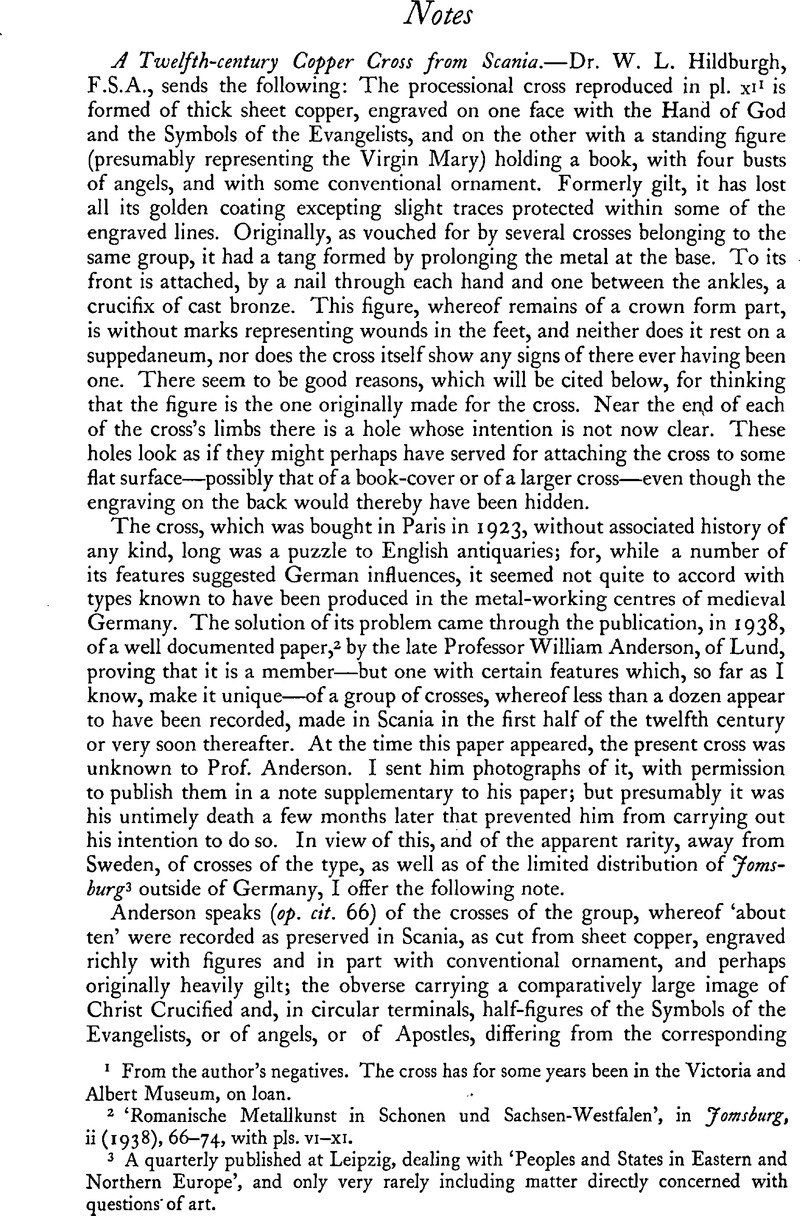No CrossRef data available.
Article contents
A Twelfth-century copper Cross from Scania
Published online by Cambridge University Press: 08 January 2012
Abstract

- Type
- Notes
- Information
- Copyright
- Copyright © The Society of Antiquaries of London 1943
References
page 48 note 1 From the author's negatives. The cross has for some years been in the Victoria and Albert Museum, on loan.
page 48 note 2 ‘Romanische Metallkunst in Schonen und Sachsen-Westfalen’, in Jomsburg, ii (1938), 66–74,Google Scholar with pls. vi-xi.
page 48 note 3 A quarterly published at Leipzig, dealing with ‘Peoples and States in Eastern and Northern Europe’, and only very rarely including matter directly concerned with questions of art.
page 49 note 1 Engraved crucifixes appear also on two crosses of the group in the parish church of Norra Svalöv'; cf. , Anderson, op. cit. 67Google Scholar.
page 49 note 2 While this arrangement may perhaps here have had no more than a decorative intention, the very frequent occurrence in some religious art (e.g. Spanish), in association with the Virgin Mary, of a closely similar four-petalled emblem suggests that it may not have been entirely fortuitous.
page 49 note 3 Cf. Rydbeck, O., ‘Utstallningen av äldre kyrklig konst från Skåne 1914’, in Aldre kyrklig konst i Skåne, Lund, 1921, fig. 44.Google Scholar
page 49 note 4 Cf. Wåhlin, Karl-vilhelm, ‘Några prov på skånsk metallkonst under 1200-talet’, in Aldre kyrklig konst i Skåne, fig. 3.Google Scholar
page 50 note 1 Cf. , Wåhlin, op. cit., fig. 5Google Scholar; , Rydbeck, op. cit., fig. 27Google Scholar.
page 50 note 2 Cf. Ugglas, C. R. af, ‘Trydecrucifixet och Lund’, in Från stenålder till rokoko, Lund, 1937, figs.2, 3Google Scholar; , Wåhlin, op. cit., fig. 6Google Scholar.
page 50 note 3 Cf. , Wåhlin, op. cit., figs. 7–11;Google ScholarUgglas, af, op. cit., fig. 4Google Scholar.
page 50 note 4 Cf. , Rydbeck, op. cit., fig. 22.Google Scholar
page 50 note 5 Cf. , Anderson, op. cit. 67.Google Scholar Excepting in general character, however, this crucifix does not particularly resemble the one on our cross.
page 50 note 6 Cf. , Wåhlin, op. cit., fig. 2; it is believed to be from Scania.Google Scholar
page 50 note 7 Cf. Ekholm, G., ‘Broddetorps altaret’, in Från stenålder till rokoko’, fig. 1Google Scholar; Nørlund, P., Gyldne altre… (with English summary, Golden Altars: Danish Metal Work from the Romanesque Period), Copenhagen, 1926, figs. 94, 13Google Scholar.
page 50 note 8 Cf. Ugglas, af, op. cit., fig. 6Google Scholar; for references to other material concerning this object, cf. ibid. 280-2, n. 6.
page 50 note 9 For a well illustrated disquisition on that art see Swarzenski's, G. ‘Aus dem Kunstkreis Heinrichs des Löwen’, in Städel-Jahrbuch, vii-viii (1932)Google Scholar.




